2021 has seen a lot of progress with the thesis of Theme 5 of the Ostia Graduirtenkolleg. The working title of this thesis is still ‘Building decor on the Forum of Ostia: For the allocation and reconstruction of the marble furnishing elements of the forum buildings in their original context’ and focuses on documenting and analyzing the vast amounts of architectural marble fragments examined by the Ostia Forum Project (OFP) in deposits/piles around the Forum of Ostia.
The main focus of my work during 2021 has been to document and organize the marble fragments, a large undertaking due to the amount of material. My work therefore has been focused on 1) creating a digital database suited for working with the architectural fragments in question and 2) to gather further data on the fragments using the existing documentation of the OFP from previous campaigns and during a find processing campaign in Ostia Antica in the autumn of 2021.
While the creation of the database and the following compiling of the already available documentation has been very successful, the collection of new data from the material in Ostia was again made difficult by the still ongoing Covid 19 pandemic. Only one campaign was possible during the year due to the pandemic, instead of the usual two – one in the spring and one in the summer. Additionally, a planned stay at the Danish Institute in April, also intended for processing the material, was canceled. I have therefore been forced to rely on the existing photographic documentation, from which I have been able to see what kinds of architectural fragments the deposits contain (fragments from column capitals, bases, architraves etc.). However, this type of documentation the lacks more precise measurements needed for detailed analysis of the fragments, which is best provided by drawings and photogrammetry. Creating a precise typology of the various fragment groups have therefore been difficult. However, on the basis of the existing photographic material, I have been able to expand the database to (at the time of writing) 590 fragments of marble and other fragments. As a result of this, I have been able to find relations between several fragments and then confirming these relations during the field campaign, as will be mentioned below.
The study of old archive material, in the shape of excavation diaries and photos, throughout the 2021 has likewise provided us with further information on the marble fragments with regards to their long-lost find contexts. This becomes especially useful in case where we are able to identify specific marble elements and fragments on photos from the time of excavation, of which two examples will be mentioned below.
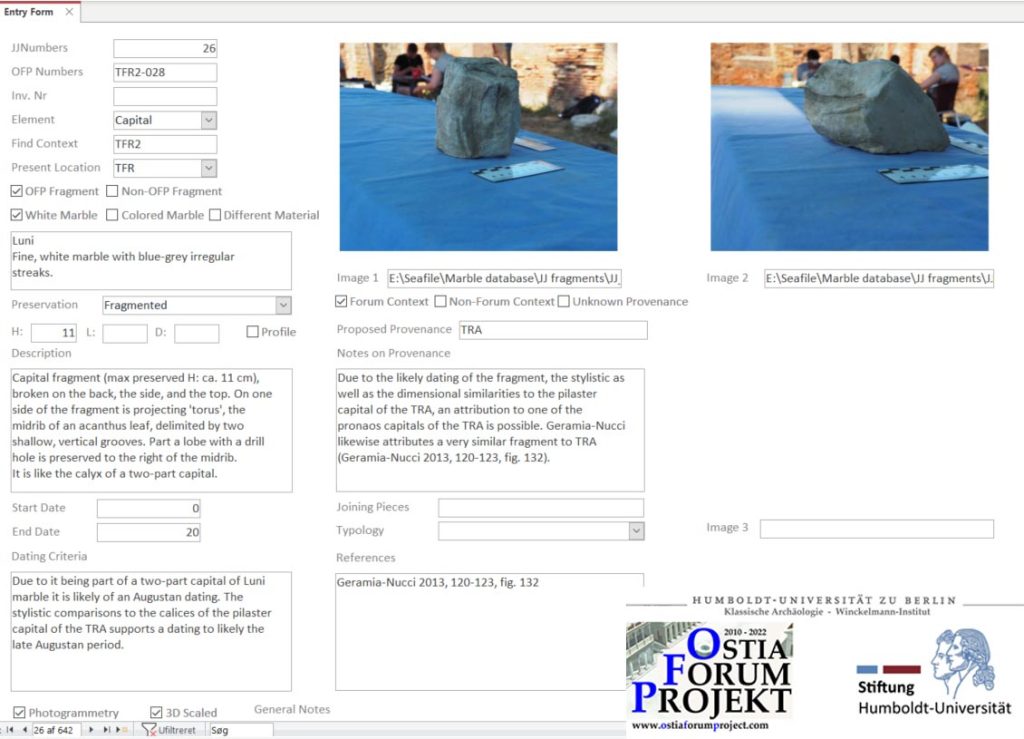
The database
The main objective of this doctoral thesis was and is to create an overview of the hundreds of interesting architectural marble elements found in the deposits around the forum. An essential tool for this endeavor was to create a functional database from which it would be easy to compare and search for specific fragments on several different parameters. The solution was a digital database which is both easy to use and is very customizable in terms of the visual layout. It is possible to create several different searchable fields, which can contain either shorter or longer texts, fields from which it you can select from a few preselected options1, or fields which are simple yes/no boxes. The result was a database, which can make search queries with very specific criteria in mind. This ranges from searching on for example which architectural elements it is (capitals, column shafts, bases, architraves, roof tiles etc.), the type of stone the fragment is carved from (marble, tuff or travertine), the dating of the fragment, or all three combined (Fig. 1).
A further advantage to this database is that allows me to store all the available information on every registered fragment in one place, instead of having it spread out over potentially several other documents, while at the same time having one or several illustrations of the fragment. A specific search results as well as the entire database can likewise be saved as a pdf document or as a printout, allowing for easy transferal of results for various occasions.
As mentioned in the introduction, the database currently contains nearly 600 fragments ranging from small fist-sized fragments to large several hundred-kilogram architectural elements, each identified with its own JJ-number2 (the running number of the database). While the vast majority of the pieces in the database are un-published fragments (OFP fragments) stemming from the forum deposits, some already known and published fragments (non-OFP fragments) have also been added. The reason behind this decision was due to the fact that the database, in its current form, is a working tool for comparing the various architectural fragments of the forum, which includes un-published and published fragments alike. Some examples of already known fragments being in the database are several fragments from the Temple of Roma and Augustus, a lot of which have been extensively published by Patrizio Pensabene and Roberta Geramia Nucci and a cornice section by Pensabene with the inv. no. 29279 (JJ_105 in the database). The latter example will be mentioned below.
Reconstructing lost contexts – clues derived from archive photos
Throughout 2021, the examination of old archive material from the photographic archive and the library of the Archeological Park of Ostia Antica by the OFP has produced some interesting results relating to the lost contexts of some the marble fragments of the forum. The stratigraphic context of archaeological material is a very important element for people wanting to understand the chronological development of an archeological site. The documentation of the stratigraphy and the objects found in it is therefore a crucial part of any present-day excavation. This, however, was not the case in the early 20th century when the forum of Ostia was being excavated. Due to the often-uncomprehensive nature of the documentation of this period, the exact find context of most of the marble fragments found during these excavations were never recorded. As a result of this, valuable information which could have shed light on for example the dating of the fragments and their provenance has been lost. After the excavation, the pieces that were deemed of particular value was moved to secure storerooms in connection to the museum or used in the reconstructions of the forum buildings, while the remaining fragments were collected into the deposits/piles, which can be found around the forum area today. In some cases, it seems that the marbles excavated in the forum area were put on top or reinserted into already existing deposits of marble fragments – some of which were old limekilns or Late Antique stores, or fragments intended for reuse in other buildings3.
An important tool for researching these marble fragments are old excavation photos from the period in which the forum was excavated. This can give us a clue as to the when exactly the deposits were formed and from in areas of the material of the specific deposits were found. This has so far been possible for the deposit, TFR_2, as well as for several individual fragments.
The deposit of TFR_2
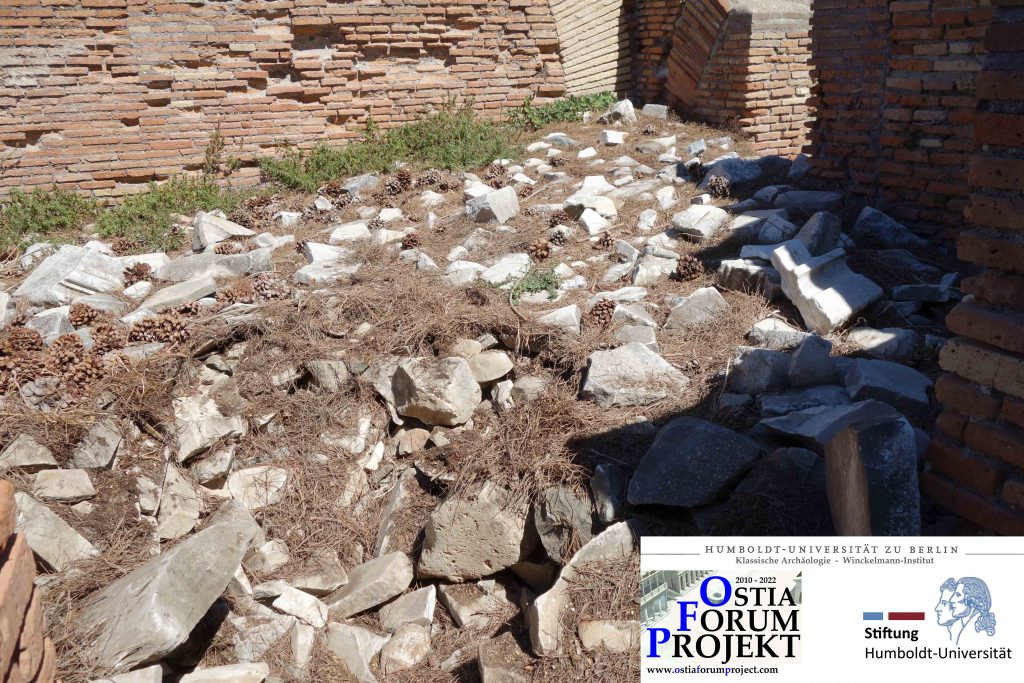
The area of TFR (Taberna Forum Rooms) is situated on the eastern side of the forum, just north of the Decumanus. The room of TFR_2 contained the largest of the marble deposits in the forum area (Fig. 2). The deposit contained thousands of fragments, which filled nearly the entire room. This deposit is well known and has been recorded as a yet unlit Antique lime kiln by scholars such as Dante Vaglieri and Raffaele Finelli4 and later by Paolo Lenzi5. However, it was not until 2016, during the examinations conducted by the OFP, that the content of the deposit was thoroughly documented. The deposit, which in some areas reached above a meter in height, can be subdivided into two distinct layers – an upper layer, which consisted of medium- to large-sized fragments and a lower layer consisting of small fist-sized fragments and small marble cut-offs.
The upper layer was characterized by modern vegetation such as pine needles, pine humus and pine-cores in between the stones. This persisted down to the core of the upper layer likely as a consequence of Finelli having mostly excavated the deposit in 1913, after which he put the marbles back into the room. The fact the Finelli put the material back into the TFR_2 seems to be evident in an archive photo from February 1915 where marble is clearly visible in the room.6 In the years after the excavations of 1913, additional material would be deposited in TFR_2 to as late as after 1989 – as indicated by empty chips bags and Coca-Cola cans with a still discernible expiration date found near the surface of the deposit.
JJ_052
While the presence of a marble deposit in TFR_2 is clearly evident from the archive material, an example of a specific fragment found in TFR_2 can also be found on the old excavation photos. The fragment in question is JJ_052, which was likely part of a clipeus with an anthemion (Fig. 3) can be seen on a photo from March 1913 of the recently uncovered northeastern part of the forum, with the Capitolium in the center7. In front of the Capitolium are two piles of marble fragments, which was found during the excavations roughly in that same area. In the left side of the pile in the foreground of the photo, JJ_052 can be seen, recognizable by its distinct decoration and fragmentation. This revelation shows us two things: 1) that a lot of discarded architectural marble fragments was used as filling material in an ancient level raise of the northern part of the forum and 2) that at some point after the excavations of 1913, at least some the marble material found here was put in into TFR_2 – a reasonable decision due to the proximity of this deposit to the forum. It would therefore also be fair to assume that more of the fragments from TFR_2 would likewise come from the fill layer(s) of the forum, however, this has yet to be thoroughly examined.
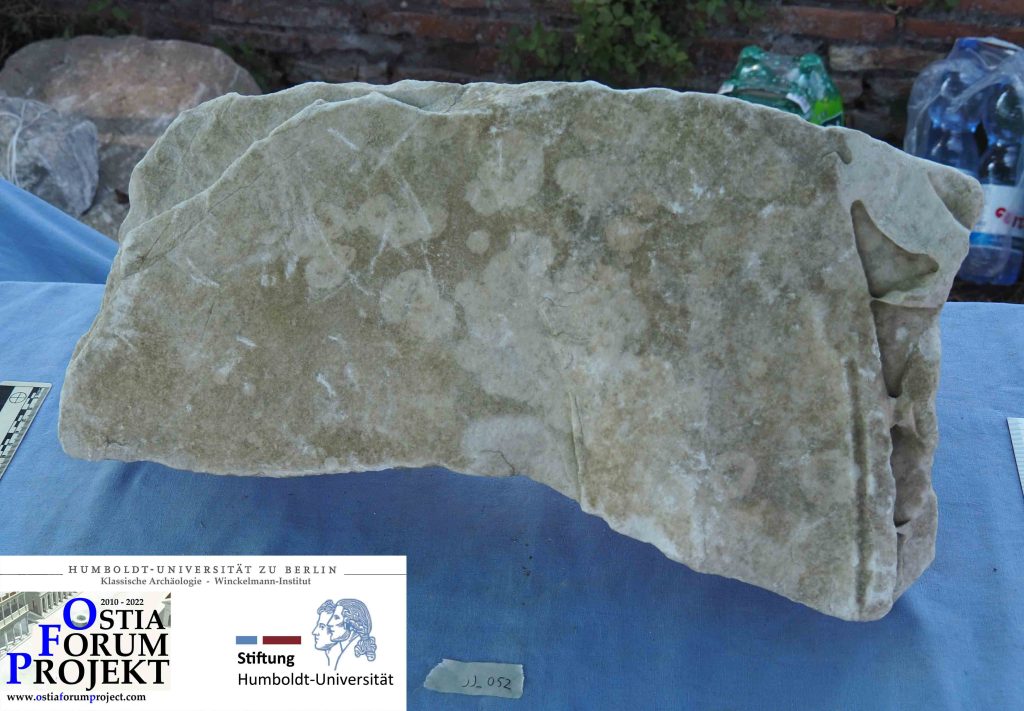
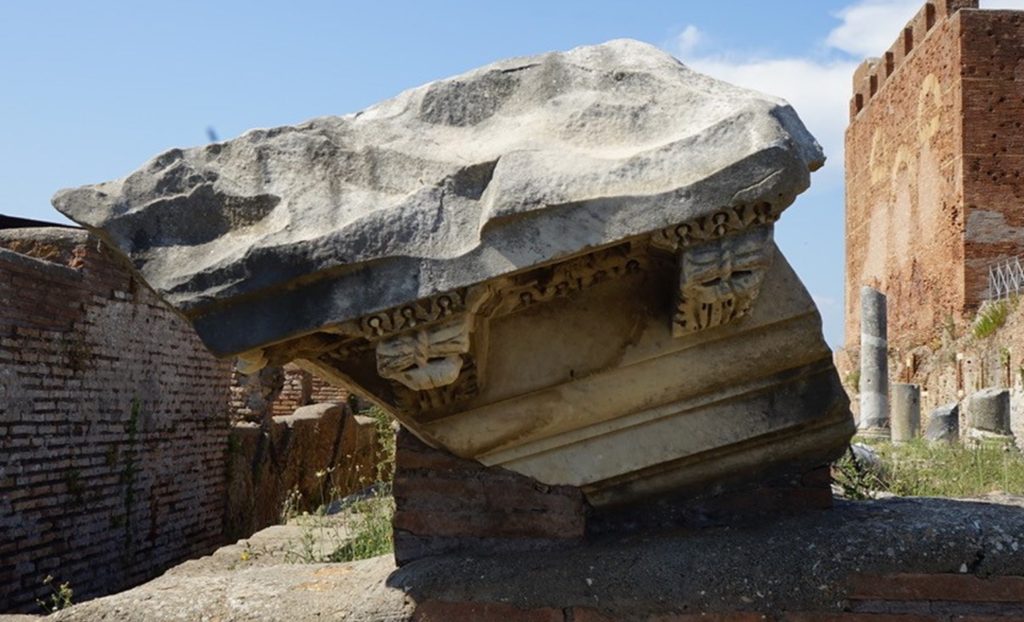
JJ_105 (Inv. 29279)
Another object which can be identified on archive photos is the already known raking cornice section decorated with two modillions and two soffits with rosettes, the so-called inv. 292798 (JJ_105 by the OFP). This section can today be seen on the southern wall of the northwest forum porticus and can be found on, not only one, but two separate archive photos.
The earliest photo is from 1924, taken just prior to the start of the excavation of the Caseggiato dei Triclini9. Here, JJ_105 can be seen laying on the Decumanus, immediately opposite the southwestern most of the TFR rooms, TFR_1. Its position here could be an indicator, although admittedly circumstantial, that it was found in the area, possibly also as part of a fill layer of the forum. The second photo of this fragment taking in192510, shows that the cornice had been moved further west along the Decumanus, now placed close to the Mundus, a small circular structure on the forum. The reason for this is unknown, however, it could be due to the excavators needing more space for the excavations in the Caseggiato dei Triclini and therefore opted to move the cornice further away.
Interesting fragments
The research of the past year yielded new insights into the several individual fragments – the majority of which stem from the TFR_2 deposit. Below are two examples of specific interest: a recently reconstructed cornice and an architrave revetment section.

A nearly complete monumental cornice
The fieldwork of 2021 confirmed the relation between three different cornice fragments to be from the same context – namely the fragments called JJ_057, JJ_058 and JJ_059 (Fig 5); something that had not previously been documented. While the relation between the fragments of JJ_058 and JJ_059 was documented in 2020 as being from the same context due to the correlation between the position of the central astragal and dental of both fragments, the relation of JJ_057 was until this point theoretical. JJ_058 and JJ_059, while not joining with each other directly, accounted for the central part of the decoration sequence of the cornice – namely beginning with a blank soffit followed by a ionic kymation (egg-and-dart motif), a bead-and-reel astragal, a dental relief, and a ionic kymation. However, the sima of the cornice i.e., the upper part of the decoration, was missing. Research done in Berlin prior to the fieldwork 2021, showed that the likely candidate for this part was JJ_057, which was decorated with a blank sima, a lesbian kymation, a bead-and-reel astragal, a blank corona and a blank soffit. Seemingly, this fragment would fit with the other two in terms of dimension and the carving style of the astragals. This relation was confirmed upon an in-person comparison of the fragments, which also revealed that JJ_057 and JJ_059 not only came from the same architectural context, but indeed physically fitted together with each other. This discovery means that we in TFR_2 have a nearly complete and previously unknown cornice from a monumental structure likely dated to the Late Augustan or early Tiberian period11. The preserved height of this cornice is 43,5 cm – likely close to the original height.
While the original context of this cornice section is still unknown, the dating of the cornice can provide us with a clue in this regard. An obvious candidate would be the Temple of Roma and Augustus, located on the southern end of the forum and the first building on the forum to be constructed mainly in marble. This temple is dated to the first quarter of the first century CE12 which correlates with the dating of the TFR_2 cornice. The size of the cornice could possibly hint at it being used in the interior of the temple.13 Another candidate of origin for this cornice could be the currently enigmatic ‘crypta et calchidicum’ of Terentia built around the same time, but so far only known from a monumental inscription14, however, that is pure speculation at this point. The origin of this cornice is of great interest, and it is an aspect, I will study further in the coming year.
A revetment plaque with an architrave soffit
Another group of fragments, which is of great interest, is the two fragments of JJ_080 and JJ_072 (Fig. 6) also from TFR_2. These two fragments were, like the above-mentioned cornice fragments, confirmed to be from the same architectural context – namely a section of revetment of an architrave soffit i.e., the lower part of an architrave. These two fragments were, as with JJ_057 and JJ_059, found to have originally been joined together, which gave us the possibility to reconstruct the entire profile of the revetment plaque. This revealed that the architrave would have been roughly 46 cm in width and 12,5 cm in height. It was decorated with a central projecting part running the length of the architrave culminating in both ends by a concave curve. The sides of the architrave are adorned with two fasciae divided by a blank astragal.
The decorative scheme for the soffit, a central projecting area with an outer frame, can be found all over the Roman world – including several examples being found in Ostia. One these is the internal architraves of the Forum’s Basilica showing the same overall shape, but with the central part being semicircular in its profile15. An important difference between these two architraves is that the basilica architraves are carved as part of a massive marble architrave while JJ_080 and JJ_072 is carved as a revetment, meaning that our fragments were used as marble face for an architrave with a brick and concrete core. An example of a brick and concrete architrave can be found in the Villa of Hadrian at Tivoli, where it is used in several porticos16.
The features which show that this fragment functioned as a revetment is mainly seen on carving technique of the upper surface of the fragments – namely that the innermost part of the plaque has been very roughly smoothed with a pointed chisel, while the edges have been smoothed neatly with a tooth-chisel, as seen on the right side of fig. 6. This is due to the fact the outer edges would need to join with the revetment slabs covering the front and back of the architrave and would therefore need to be a smooth as possible to prevent a visible gap between the two elements. The inner part of the architrave soffit, on the other hand, did not need to be as carefully smoothed, since this would be facing the mortar core of the architrave and could therefore not be seen. The rough surface would have the additional benefit of better being able to stick to the mortar than a smooth surface would.
The dating and origin of this architrave is, as of yet, uncertain apart from it being from the Imperial period, where the use of marble was most widespread. This is an aspect that I, as with the cornice, will attempt to find out in the coming year.
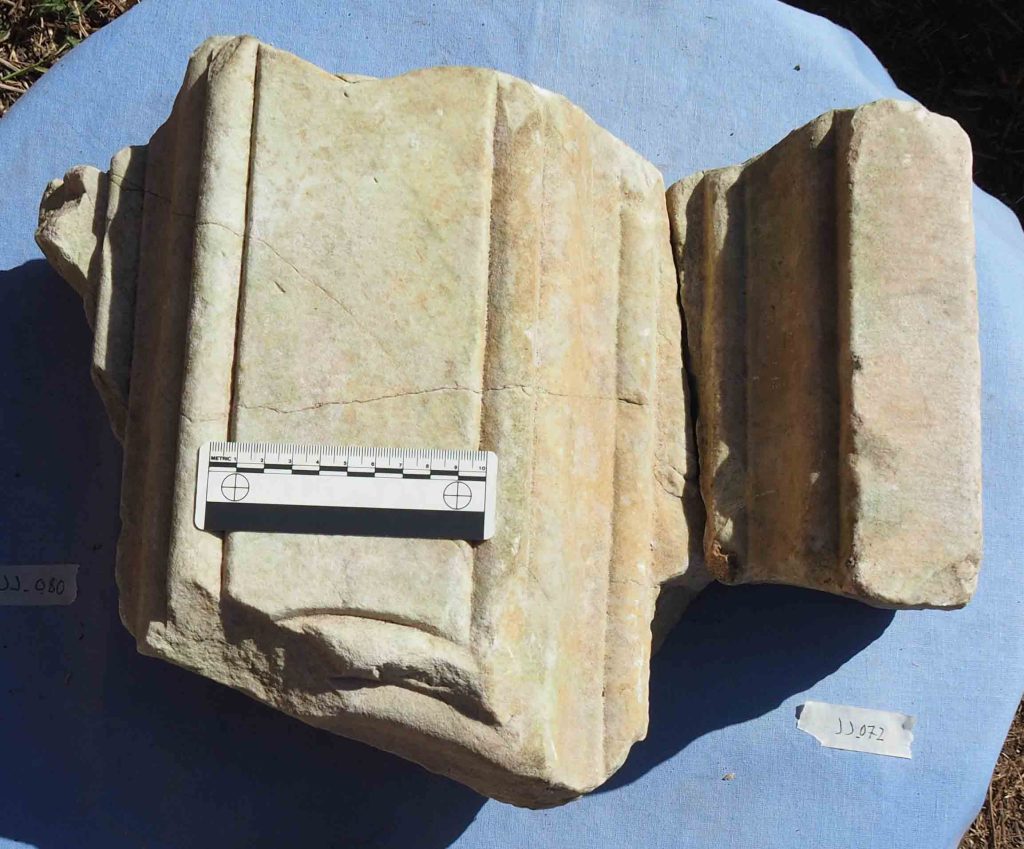
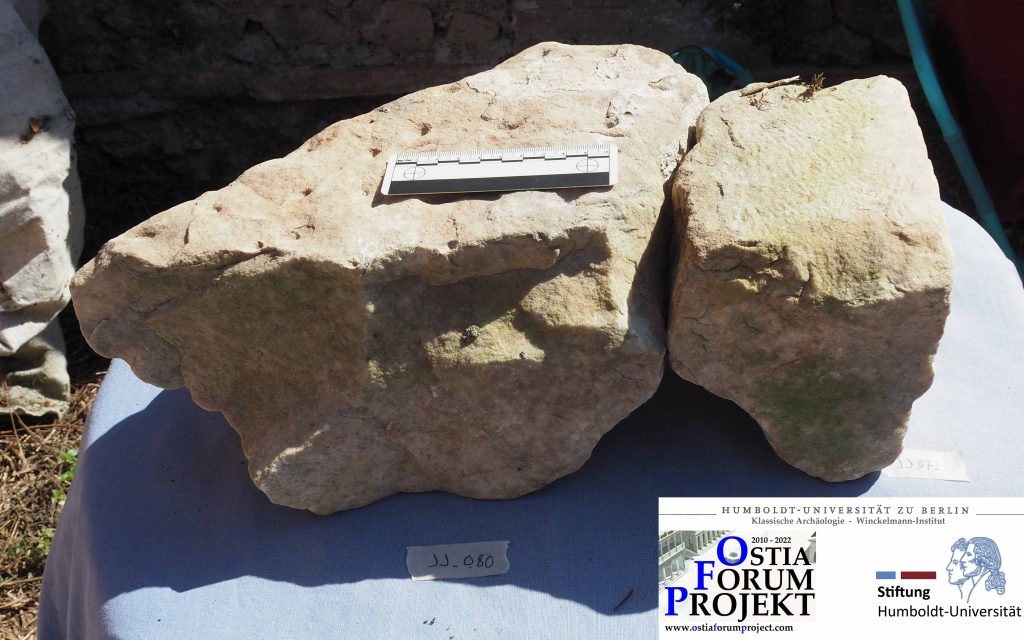
3D reconstructions
An important part of not only my research, but for the OFP as a whole, is the brilliant 3D reconstructions of several buildings from the Forum of Ostia constructed by MA Steven Götz via the software 3D modeling software. These reconstructions are a valuable research tool in several ways, since they allow us to not only visualize how the building would have appeared from several angles at once, but also allows us to test out various different theories as to the building’s appearance and proportions. These reconstructions are capable of integrating photogrammetric 3D models of the actual fragments, which lets us (virtually) insert fragments back into their original position on the building. Alternatively, it is also possible to insert the reconstruction into a photogrammetric model of the forum as it looks today, directly on the remains of the buildings in question. The buildings which have so far been recreated in this manner is the Temple of Roma and Augustus, the predecessor temples of the Capitolium, and the until now unknown sanctuary in the northeastern part of the forum with its different temple phases (T1a-d). While these reconstructions are still a work in progress, they have already revealed a great deal in terms the construction of the buildings and of how the buildings of the forum related to each other.
Future plans for the thesis
The plan for the continued work on the thesis in 2022 will focus on several aspects: 1) finishing the detailed documentation of as many fragments as possible, 2) analyzing the material via the creation of typologies of the various interesting fragments of the marble deposits and 3) the writing the thesis itself. With regards to the remaining documentation of the marble fragments, the planned field campaign of February and March will be crucial. This campaign with be dedicated to thoroughly documenting the most important fragments from the remaining deposits around the forum – mainly the deposits of TRD and DTD located between the Tempio Rotondo and the forum. The priority would be to document the accurate dimensions of the fragments, via either drawings, photogrammetric 3D models or both. The data achieved from these will be essential in dividing the fragments into distinguishable types, which can then possibly be attributed to known buildings around the forum.
A planed stay at the Danish Institute in Rome in May will provide an opportunity for me to find comparisons to my material in Ostia in the city of Rome and its surroundings. Specific areas of interest would be the architectural decorations of the various monuments in Rome such as on the Forum Romanum, the Palatine Hill, the Imperial fora, as well as churches where ancient spolia has been used, such the Basilica di Santa Sabina all’Aventino. I also plan to visit some of the many museums of the city such as the Capitoline Museums, Vatican Museums, and the Crypta Balbi, all of which have a lot of pieces of interest. Outside of Rome itself the site of Hadrian’s Villa at Tivoli will be an essential site to visit. A stay in at the Institute will likewise provide me with an opportunity to utilize the city’s many libraries, which will be very useful for writing the thesis itself.
References
- This is very useful for avoiding spelling errors, which would make the criterion in question not show up during a search in the database.
- JJ is an abbreviation of the name of the author of this doctoral thesis, Jesper Jensen.
- For more on the industry of reusing/recutting marbles on the forum in Late Antiquity, see Gering 2016.
- Giornale degli Scavi 1913, 195.
- Lenzi 1998, 259, sito 12.
- PAOst, AF B 2196.
- PAOst, AF, A 2426.
- Pensabene 2007, 264, tav. 77,1.
- PAOst, AF A 2477.
- PAOst, AF A 2462.
- The dating is based the style and depth of the carving of the decoration.
- Geremia Nucci 2013, 162-183.
- For possible reconstructions of the interior of the Temple of Roma and Augustus, see Gering 2020.
- Mar 2002, 118.
- Pensabene 2007, 215, fig. 118, tav. 56, 4-5.
- See for example the Doric portico of the Edificio con Pilastri Dorici.
Bibliography
Giornale degli Scavi, 1913. (Unpublished)
Gering, A. 2016. ’Brüche in der Stadtwahrnehmung. Bauten und Bildausstattung des Forums von Ostia im Wandel.’ in A. Haug – P. Kreuz (editors), Stadterfahrung als Sinneserfahrung in der römischen Kaiserzeit, 2016, pp. 247-266.
Geremia Nucci, R. 2013. Il Tempio di Roma e di Augusto a Ostia. Rome.
Gering, A. 2020. ’Zum Aussagewert umgenutzter Bauteile des Roma- und Augustustempels für die Bau- und Verfallsgeschichte Ostias. Ergebnisse der Spoliensurveys 2016–2018 des Ostia-Forum-Projekts (OFP)’, in K. Piesker and U. Wulf-Rheidt, Umgebaut. Umbau-, Umnutzungs- und Umwertungsprozesse in der antiken Architektur. Internationales Kolloquium in Berlin vom 21.–24. Februar 2018 veranstaltet vom Architekturreferat des DAI, pp. 383-402.
Lenzi, P. 1998. ‚”Sita in loco qui vocatur calcaria” : attività di spoliazione e forni da calce a Ostia.’ In: Archeologia medievale 25, 1998, pp. 247-263.
Mar, R. 2002. ‘Ostia, una ciudad modelada por el comercio. La construcción del Foro.’ In: Mélanges de l’École française de Rome. Antiquité, tome 114, n°1. 2002, pp. 111-180.
Pensabene, P. 2007. Ostiensium marmorum decus et decor. Studi architettonici, decorativi e archaeometrici. Rome.
